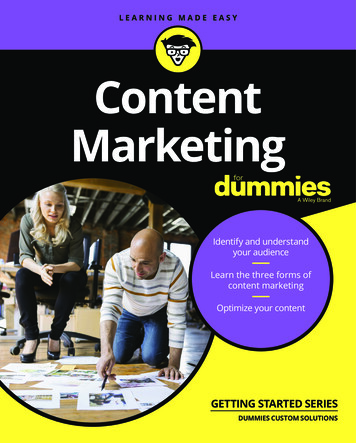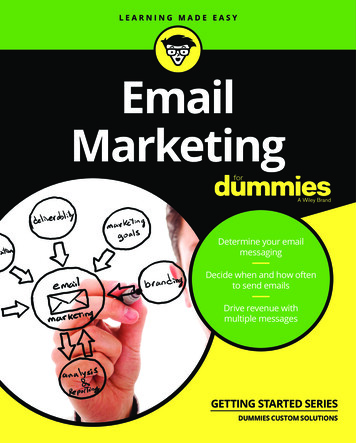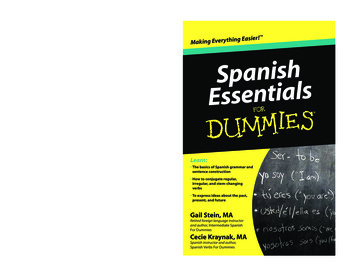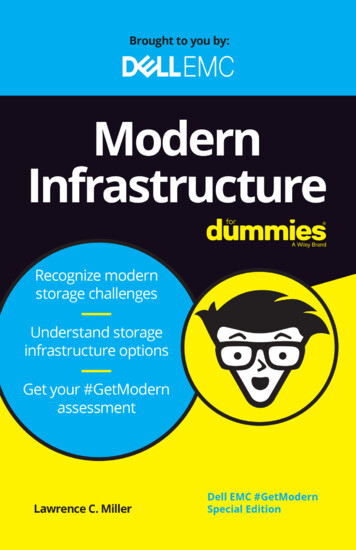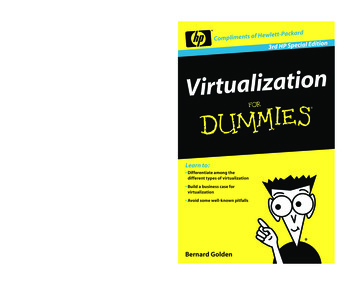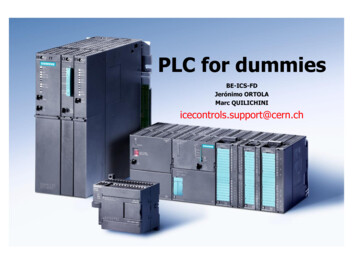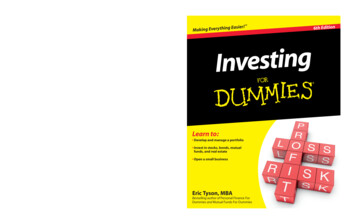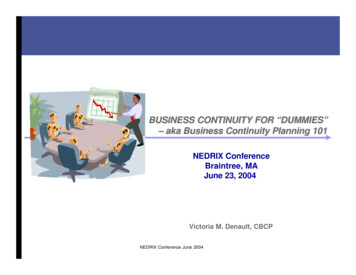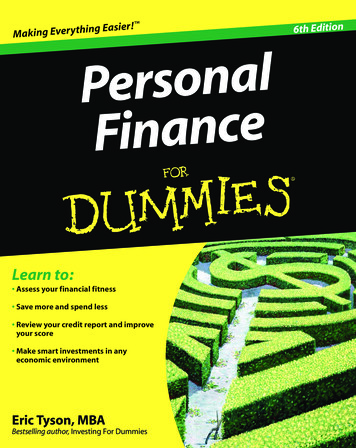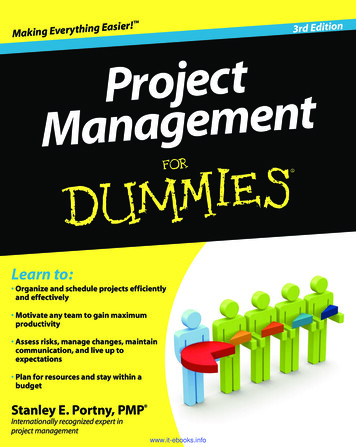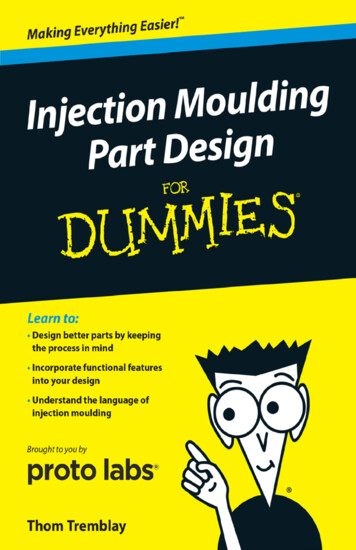
Transcription
These materials are 2012 John Wiley & Sons, Inc . Any dissemination, distribution, or unauthorized use is strictly prohibited.
Injection MouldingPart DesignFORDUMmIES‰PROTO LABS‰ SPECIAL EDITIONby Thom TremblayThese materials are 2012 John Wiley & Sons, Inc . Any dissemination, distribution, or unauthorized use is strictly prohibited.
Injection Moulding Part Design For Dummies, Proto Labs Special EditionPublished byJohn Wiley & Sons, Inc.111 River StreetHoboken, NJ 07030-5774www.wiley.comCopyright 2012 by John Wiley & Sons, Inc., Hoboken, NJPublished by John Wiley & Sons, Inc., Hoboken, NJNo part of this publication may be reproduced, stored in a retrieval system or transmitted in anyform or by any means, electronic, mechanical, photocopying, recording, scanning or otherwise,except as permitted under Sections 107 or 108 of the 1976 United States Copyright Act, without theprior written permission of the Publisher. Requests to the Publisher for permission should beaddressed to the Permissions Department, John Wiley & Sons, Inc., 111 River Street, Hoboken, NJ07030, (201) 748-6011, fax (201) 748-6008, or online at http://www.wiley.com/go/permissions.Trademarks: Wiley, the Wiley logo, For Dummies, the Dummies Man logo, A Reference for the Restof Us!, The Dummies Way, Dummies.com, Making Everything Easier, and related trade dress aretrademarks or registered trademarks of John Wiley & Sons, Inc. and/or its affiliates in the UnitedStates and other countries, and may not be used without written permission. Proto Labs is aregistered trademark of Proto Labs, Inc., and may not be used without Proto Labs, Inc.’s permission.All other trademarks are the property of their respective owners. John Wiley & Sons, Inc., is notassociated with any product or vendor mentioned in this book.LIMIT OF LIABILITY/DISCLAIMER OF WARRANTY: THE PUBLISHER AND THE AUTHOR MAKENO REPRESENTATIONS OR WARRANTIES WITH RESPECT TO THE ACCURACY ORCOMPLETENESS OF THE CONTENTS OF THIS WORK AND SPECIFICALLY DISCLAIM ALLWARRANTIES, INCLUDING WITHOUT LIMITATION WARRANTIES OF FITNESS FOR APARTICULAR PURPOSE. NO WARRANTY MAY BE CREATED OR EXTENDED BY SALES ORPROMOTIONAL MATERIALS. THE ADVICE AND STRATEGIES CONTAINED HEREIN MAY NOT BESUITABLE FOR EVERY SITUATION. THIS WORK IS SOLD WITH THE UNDERSTANDING THATTHE PUBLISHER IS NOT ENGAGED IN RENDERING LEGAL, ACCOUNTING, OR OTHERPROFESSIONAL SERVICES. IF PROFESSIONAL ASSISTANCE IS REQUIRED, THE SERVICES OF ACOMPETENT PROFESSIONAL PERSON SHOULD BE SOUGHT. NEITHER THE PUBLISHER NORTHE AUTHOR SHALL BE LIABLE FOR DAMAGES ARISING HEREFROM. THE FACT THAT ANORGANIZATION OR WEBSITE IS REFERRED TO IN THIS WORK AS A CITATION AND/OR APOTENTIAL SOURCE OF FURTHER INFORMATION DOES NOT MEAN THAT THE AUTHOR ORTHE PUBLISHER ENDORSES THE INFORMATION THE ORGANIZATION OR WEBSITE MAYPROVIDE OR RECOMMENDATIONS IT MAY MAKE. FURTHER, READERS SHOULD BE AWARETHAT INTERNET WEBSITES LISTED IN THIS WORK MAY HAVE CHANGED OR DISAPPEAREDBETWEEN WHEN THIS WORK WAS WRITTEN AND WHEN IT IS READ.For general information on our other products and services, please contact our BusinessDevelopment Department in the U.S. at 317-572-3205. For details on how to create a custom ForDummies book for your business or organization, contact info@dummies.biz. For informationabout licensing the For Dummies brand for products or services, contactBrandedRights&Licenses@Wiley.com.ISBN: 978-1-118-20401-6 (pbk); ISBN: 978-1-119-47557-6 (ebk)Manufactured in the United States of America10 9 8 7 6 5 4 3 2 1These materials are 2012 John Wiley & Sons, Inc . Any dissemination, distribution, or unauthorized use is strictly prohibited.
Table of ContentsIntroduction . . . . . . . . . . . . . . . . . . . . . . . . . . . . . . . . . . . . . . 1About This Book. 1Foolish Assumptions. 2How This Book Is Organised. 2Chapter 1: Wrapping Your Head aroundInjection Moulded Parts. 2Chapter 2: Pinning Down Your Job Needs. 2Chapter 3: A Beginner’s Guide to the Perfect Part. 3Chapter 4: Going Beyond a Straight-Pull Mould. 3Chapter 5: Adding the Finishing Touches. 3Chapter 6: Ten (Or So) Ways to Give Your Partsthe Proto Labs Edge. 3Icons Used in This Book. 4Where to Go from Here. 4Chapter 1: Wrapping Your Head aroundInjection Moulded Parts . . . . . . . . . . . . . . . . . . . . . . . . . 5Getting Grounded in Injection Moulding. 6Meeting the machine. 6Making the part. 7Keeping design in mind. 7Breaking Down the Part-Making Process. 8Starting the part with the mould. 8Talking straight about straight-pull moulds.8Knowing the core from the cavity. 9Doing a runner. 9Getting out of the gates. 12Keeping your cool. 14Prepping Parts for Proto Labs. 16Quote system. 16Part size and configuration. 16Chapter 2: Pinning Down Your Job Needs. . . . . . . . . . . 17Getting Materialistic. 17Matching resins to part functions. 18Reviewing resin properties. 19Considering blends. 21These materials are 2012 John Wiley & Sons, Inc . Any dissemination, distribution, or unauthorized use is strictly prohibited.
ivInjection Moulding Part Design For DummiesPondering the Need for a Pretty Part. 21The A side: Form. 22The B side: Function. 22Facing the Details. 23Building great walls. 23Making smooth transitions. 23Matching thickness to material. 24Making an important draft pick. 25Draft-angle guidelines. 26Texture effects. 27Rounding the bends. 27Parting is such sweet sorrow. 28Making Parts at Warp Speed. 29Getting that sinking feeling. 30Filling the mould. 31Chapter 3: A Beginner’s Guide to the Perfect Part. . . . 33Ordering the Ribs. 33Meeting the Boss. 35Feeling a Draft. 36Keeping the Fillets Consistent. 37Getting a Feel for Texture. 37Featuring Multiple Features. 38Making the Write Decision about Text. 40Chapter 4: Going Beyond a Straight-Pull Mould. . . . . . 43Solving Problems from the Side. 43Knowing when to use side-action cams. 44Seeing what sizes the cams can be. 45Shutting off the action. 45Adding Resistance with Bumpoffs. 48Making Mouldmaking Simpler with Inserts and Pins. 49Picking out inserts. 49Pinning down the core. 49Designing for High Productivity. 51Designing a mould for multiple parts. 51Accommodating side-actions inmulti-cavity moulds. 51Mirror, Mirror: Making Mirrored Parts. 52Chapter 5: Adding the Finishing Touches. . . . . . . . . . . . 55Colouring Your Parts. 55Colouring from the outside: Painting. 56Colouring from the inside: Adding colourant. 56Designing a Big Finish. 58These materials are 2012 John Wiley & Sons, Inc . Any dissemination, distribution, or unauthorized use is strictly prohibited.
Table of ContentsvChapter 6: Ten (Or So) Ways to Give Your Parts theProto Labs Edge. . . . . . . . . . . . . . . . . . . . . . . . . . . . . . . . 59Proto Labs Know-How. 59Access to Experts. 60Proprietary Technologies and Tools. 60Real Parts Made Rapidly. 61Mass-Production Readiness. 61Multiple Finishes. 62On Demand Manufacturing. 62Glossary . . . . . . . . . . . . . . . . . . . . . . . . . . . . . . . . . . . . . . . . 63These materials are 2012 John Wiley & Sons, Inc . Any dissemination, distribution, or unauthorized use is strictly prohibited.
Publisher’s AcknowledgmentsWe’re proud of this book and of the people who worked on it. For details on how tocreate a custom For Dummies book for your business or organization, contact info@dummies.biz. For details on licensing the For Dummies brand for products orservices, contact BrandedRights&Licenses@Wiley.com.Some of the people who helped bring this book to market include the following:Acquisitions, Editorial, and VerticalWebsitesSenior Project Editor: Zoë WykesDevelopment Editor: Kathy SimpsonEditorial Manager: Rev MengleBusiness Development Representative:Kimberley SchumackerCustom Publishing Project Specialist:Michael SullivanComposition ServicesSenior Project Coordinator: Kristie ReesLayout and Graphics: Tim DetrickProofreaders: Lindsay Amones,Melissa CossellSpecial Help: Grace Fairley,Amanda Graham, Barbara MooreDummies Publishing, United KingdomMichelle Leete, Vice President, Consumer and Technology Publishing DirectorDavid Palmer, PublisherPublishing and Editorial for Technology DummiesRichard Swadley, Vice President and Executive Group PublisherAndy Cummings, Vice President and PublisherMary Bednarek, Executive Director, AcquisitionsMary C. Corder, Editorial DirectorPublishing and Editorial for Consumer DummiesKathleen Nebenhaus, Vice President and Executive PublisherComposition ServicesDebbie Stailey, Director of Composition ServicesBusiness DevelopmentLisa Coleman, Director, New Market and Brand DevelopmentThese materials are 2012 John Wiley & Sons, Inc . Any dissemination, distribution, or unauthorized use is strictly prohibited.
IntroductionWe live in the Age of Plastic. Consumer items, medicaldevices, and pretty much every other types of products you can think of contain plastics. Plastics form structuralcomponents or provide a personal touch to consumer goods,making products feel smooth and light in your hand.That’s all well and good. The problem is that it can take forever to get a plastic part made. First, you have to know howa plastic part is supposed to be designed; next, you have tofind a company that can make the parts; then you have towait until that company has time in its manufacturing schedule to start your job. After you’ve waited a few months, youmay discover that you didn’t know as much about designingplastic parts as you thought you did. Worse, sometimes thepeople who make your parts let you know what is wrong withyour design after the mould has been cut. (If you’re lucky,the people who make the part also cut the mould, so there’sa small chance that fixing the mould will be a priority — buteither way, you’re likely to be paying a price for it.)This scenario is a scary one, isn’t it? It’s about enough tomake you want to find a woodcarver who can whittle yourparts for you.About This BookInjection Moulding Part Design For Dummies, Proto LabsSpecial Edition, provides insight into the Proto Labs processthat makes it possible for you to get plastic parts made, not inweeks but in as little as one day. In this book, I give you tipson how to design your parts to make them better and easierto manufacture. I also tell you about design options that alloweven complex parts to be made quickly. Further, if all thatmaterial isn’t enough, I provide an overview of some of thematerials available and show how you can make your partslook like a million dollars without spending that much orwaiting forever.These materials are 2012 John Wiley & Sons, Inc . Any dissemination, distribution, or unauthorized use is strictly prohibited.
2Injection Moulding Part Design For DummiesFoolish AssumptionsEngineering departments and even private individuals nowhave ready access to design tools that are light years aheadof what was available even a few years ago. Being able todevelop a part in 3D on a computer can help you better visualise the part and evaluate what needs to be included in thedesign. This will help with making sure it can be manufactured and be functional in the real world. The challenge ishaving the background in plastic-parts design to take controlof these design tools.This book assumes that you have access to design tools likethese, have an existing design that you want to produce, anddon’t have the capability to do the manufacturing yourself.How This Book Is OrganisedI’ve organised this book into six chapters, each written tostand on its own, so you don’t necessarily have to read it fromstart to finish. Feel free to jump in wherever it makes the mostsense for you to start, based on your experience.Chapter 1: Wrapping Your Headaround Injection Moulded PartsIn Chapter 1, I introduce some of the terminology and providean overview of the process of making an injection mouldedpart.Chapter 2: Pinning DownYour Job NeedsIn Chapter 2, the focus is on the function of the part andhow it affects the material, the finish, and even the designapproach. The chapter also introduces more complex concepts such as material selection, draft angle, and adding filletsto your parts.These materials are 2012 John Wiley & Sons, Inc . Any dissemination, distribution, or unauthorized use is strictly prohibited.
Introduction3Chapter 3: A Beginner’s Guideto the Perfect PartMould design considerations for creating injection mouldedplastic parts are the main topics of Chapter 3. I cover the critical details of mouldmaking, such as ribs, walls, and bosses,and how to design features that affect the look of the part —like adding texture or text.Chapter 4: Going Beyonda Straight-Pull MouldIf you think your part is too complicated to be made quickly,Chapter 4 is for you. This chapter covers ways to makeadvanced features in the injection moulding process andexplains that when one technique doesn’t work, there’sanother that might do the trick.Chapter 5: Adding theFinishing TouchesChapter 5 introduces the all-important subjects of colour andsurface finish. Knowing what options you have is important sothat your parts look as good as you imagined they would.Chapter 6: Ten (Or So) Waysto Give Your Parts theProto Labs EdgeThis chapter discusses how expertise, experience, andtechnology work together to make it possible for you to getyour parts made quickly and productively with Proto Labsinjection moulding service.These materials are 2012 John Wiley & Sons, Inc . Any dissemination, distribution, or unauthorized use is strictly prohibited.
4Injection Moulding Part Design For DummiesIcons Used in This BookOccasionally, you’ll see special icons that call attention toimportant information. Don’t bother double-clicking the page;just sit up and take note! Here’s what you can expect.The Remember icon points out important information to helpyou retain the details.When you see the Tip icon, you can be sure that it offers information that will transform your perception of the universe —or that it just points out some information that could come inhandy while you’re designing parts.Pay careful attention wherever you see the Warning iconbecause failing to heed this information could cost you time,money, and/or damaged parts.Where to Go from HereYou can take a second look at the Table of Contents to seewhat subjects you’re familiar with, and then start with a familiar topic. But because the Proto Labs approach to mouldingplastic parts is unique, I suggest that you may well benefit byreading from the beginning.What’s the worst thing that could happen if you read straightthrough? Take a chance, and see whether you find the ProtoLabs approach to moulding parts as interesting as I do.These materials are 2012 John Wiley & Sons, Inc . Any dissemination, distribution, or unauthorized use is strictly prohibited.
Chapter 1Wrapping Your Headaround InjectionMoulded PartsIn This Chapter Getting the fundamentals right Seeing how injection moulded parts are made Readying parts for injection mouldingNo matter where you turn, you see things made out ofplastic, and most of those things are composed of plastic parts. Clearly, people have been making plastic parts fora long time, gathering a lot of expertise along the way, andnow manufacturers can make those parts quickly and well. Ifyou’re reading this book, you’re probably thinking about getting some plastic parts made, and you want to know how you,too, can do so quickly and well.Most plastic parts are created in a process called injectionmoulding, which involves injecting molten plastic into an openspace in a device called a mould. The name injection mouldingisn’t going to win any originality awards, but the process itselfis creative because it helps people turn incredible ideas intoreal parts. Knowing how injection moulding works makes iteasier to design parts for the process. This chapter gives youthat understanding.These materials are 2012 John Wiley & Sons, Inc . Any dissemination, distribution, or unauthorized use is strictly prohibited.
6Injection Moulding Part Design For DummiesGetting Grounded inInjection MouldingFor all of the big-brained science involved in injection moulding, the process can be broken down into a few basic steps:1. Melt the plastic pellets.2. Inject the melted plastic into the mould.3. Let the moulded part cool.4. Eject the finished part out of the mould.This section gives you a broad overview of these steps. Formore detail, see “Breaking Down the Part-Making Process”later in this chapter — and the rest of this book.Meeting the machineUnderstanding how injection moulding works starts withunderstanding the equipment that makes the mould: the injection moulding machine (see Figure atersEjectionramCavityFigure 1-1: Schematic of a typical injection moulding machine.These materials are 2012 John Wiley & Sons, Inc . Any dissemination, distribution, or unauthorized use is strictly prohibited.
Chapter 1: Wrapping Your Head around Injection Moulded Parts7Making the partThe injection moulding process starts with feeding pellets ofplastic resin into the hopper of an injection moulding machine(see Figure 1-1), which melts those pellets through a combination of heat and pressure. The heat comes from electricalbands on the outside of the barrel. The pressure comes froma variable pitch screw in the barrel.This screw drives the pellets from one end of the barreltoward the mould. The ram, similar to the hydraulic cylindersyou might see on an earth-moving machine, builds the pressure needed to force the plastic into the mould. When themolten plastic resin is soft enough, the ram pushes the screwforward, driving the plastic through a small nozzle into acavity in the mould, where the part takes shape.After the mould is filled, it’s left to cool.Finally, when the plastic has cooled long enough for the partto harden, the mould is opened, and the part is ejected.Keeping design in mindMost of the work of designing an injection mould focuses onwhat happens between two points: When the ram moves forward When the mould is opened to produce the partMost of this book focuses on how you can make sure thatwhat comes out of the mould is what you need it to be.Keeping the mould in mind while you design a part helps youfind ways to create high-quality parts cost-effectively.If a part is designed in a way that allows it to be high quality in a prototype tool in low quantities, it’s also going to behigh quality when you want to produce a million of them.Also, understanding how a part will be used can save adramatic amount of time by allowing you to look at variousapproaches.These materials are 2012 John Wiley & Sons, Inc . Any dissemination, distribution, or unauthorized use is strictly prohibited.
8Injection Moulding Part Design For DummiesDon’t be too shocked if you’re asked to change minor aspectsof a part. When these requests come up, they come up forgood reason, and the people who ask them don’t take themlightly. Collaborating and working with experienced peopleultimately gives you a better part in the long run.Breaking Down thePart-Making ProcessThe previous section introduced the four basic steps of injection moulding, but there’s much more to know. If you’re interested in getting parts made, you need to understand all thedetails of the process because you need to pay extra attention to some fine points when you’re developing parts to bemoulded. This section gets you started on your detail work.Starting the part with the mouldBecause you can’t have an injection-moulded plastic partwithout having an injection mould, it’s important to start bythinking about how your mould will be made, how it will work,and how you can get the best possible part from it.A mould has many components. At first glance, it looks like abunch of metal plates sandwiched together — which, oddlyenough, is pretty much what a mould is. The plates and pieceshave different functions, however, and can require somereally amazing skill to build.Talking straight about straight-pull mouldsAlthough you will find some variations in injection moulds,the most common style is the straight-pull mould. This mouldcentres on a work piece made of at least two pieces of steel oraluminium, held together with mechanical clamps or hydraulic pressure while the plastic is injected and then pulledstraight apart (surprise!) when the plastic has cooled enoughto remove the part.You can add pieces called side-actions (also called cams orslides) to the mould to create openings in the sides of parts orto create more complex features. Side-actions make it easierto create more complex parts while still using a basic mould.These materials are 2012 John Wiley & Sons, Inc . Any dissemination, distribution, or unauthorized use is strictly prohibited.
Chapter 1: Wrapping Your Head around Injection Moulded Parts9Spinning the mould analogyHere’s another way to think aboutthe halves of a mould: The halvesare usually referred to as the A and Bsides, much like the vinyl records ofold. As with records, the A side is theone that gets most of the attention,but the B side is probably more interesting. The two sides of the mouldcombine to enclose what is referredto as the cavity.Knowing the core from the cavityAt the centre of the big mould assembly are the two halves thatcreate the hollow where the melted plastic goes (see Figure 1-2).These halves are the core and the cavity, and they work likethis: Core: The core is usually the interior or noncosmetic sideof the part. The core side also contains the ejection mechanism used to push the completed part out of the mould. Cavity: The cavity is the void inside the mould that themolten plastic fills. Plastic enters the mould from thecavity side and forms the final shape of the part. Thecavity side usually forms the cosmetic side of the part.To get the benefits of the Proto Labs process, all youneed to do is focus on the design of the part and makesure that it follows the guidelines in this book.Doing a runnerAs “Making the part” explained earlier in this chapter, themolten plastic from the extruder is pushed into the mould,entering it through a series of channels called a runner system(see Figure 1-3). At different stages of the process, the partsof the channel have different names (sprue, runner, gate), butthey’re always part of the runner system.Defining the runner system is one of the true arts of moulddesign. Being able to maintain a smooth flow of material whilemaking sure the whole cavity fills — and fills correctly — isthe sort of thing that makes rocket scientists nervous.These materials are 2012 John Wiley & Sons, Inc . Any dissemination, distribution, or unauthorized use is strictly prohibited.
10Injection Moulding Part Design For DummiesCavity (top)Part (middle)Core (bottom)Figure 1-2: A part between a mould’s core and cavity.These materials are 2012 John Wiley & Sons, Inc . Any dissemination, distribution, or unauthorized use is strictly prohibited.
Chapter 1: Wrapping Your Head around Injection Moulded PartsPart11SprueGateRunnerFigure 1-3: The runner system guides the melted plastic to the cavity thatforms the part.The runner system has to make sure that the mould can fill —but not too fast or too slow. It also has to make sure that thepressure doesn’t get too high or too low. The runner systemis usually defined when designing the mould.If you’ve ever built a model car or an aeroplane, you’ve seengreat examples of a runner system in the pieces to which themodel parts are attached, as follows: Sprue: The sprue is the main channel through which theplastic enters the mould. It’s typically larger than theother channels because the plastic for the entire partflows through it. In an aeroplane model kit, for example,the sprue is the thickest cylinder that rises above therest of the plastic piece. Runners: The sprue connects to the runners, which connect all the parts and spread the plastic along the facewhere the halves of the mould meet. If you build a modelThese materials are 2012 John Wiley & Sons, Inc . Any dissemination, distribution, or unauthorized use is strictly prohibited.
12Injection Moulding Part Design For Dummiescar from a kit, the runners are the sticks that run alongside all the parts and branch out from the sprue. Gates: The runners connect to the gates, which controlthe flow of the plastic into the cavity (I discuss this morein the next section). On your model car, the gate is whereyour part breaks off when you twist it.You probably won’t want people to see your finished partwith the runner system attached. You can remove the partfrom the cool-looking runner system, and the runner can beappropriately admired or recycled by grinding it into pelletsand running it back through the moulding machine to makethe next part. It’s like a polymer circle of life.Getting out of the gatesAfter you create a runner system, the next elements of themould that you need to work out are the gates, which are theconnections where the runners meet the cavity. Gates comein a variety of shapes and can manoeuvre the plastic into thecavity in various ways.The locations of gates are important because if you want a partto come out of the mould looking like you thought it would, youmust make sure that the plastic flows to all parts of the cavity. Ifyou put the gates in the wrong places, that flow won’t happen.Following are a few types of gates you may want to use: Edge: Edge gates port plastic into the cavity through theedge of the part (see Figure 1-4). Injecting the plasticthrough the edge leaves the runner and the part connected when the process is complete. It’s easy to trim orbreak the part off the runner, but an edge gate leaves asmall imperfection called a vestige.If you need the edges of the part to remain clean, a coupleof other gate types can keep your part looking cleaner. Tunnel: Tunnel gates inject the plastic into the cavityfrom a port that’s cut into the core side of the mould andcomes back up into a portion of the part (see Figure 1-5). Post: Post gates (see Figure 1-6) allow the plastic to be shotinto the back of the mould via the paths of ejector pins(see the next section). The downside is that the ejectorThese materials are 2012 John Wiley & Sons, Inc . Any dissemination, distribution, or unauthorized use is strictly prohibited.
Chapter 1: Wrapping Your Head around Injection Moulded Parts13will push the plastic ou
create a custom For Dummies book for your business or organization, contact info@ dummies.biz. For details on licensing the For Dummies brand for products or services, contact BrandedRights&Licenses@Wiley.com. Some of the people who helped bring this book to market include the following: Acquis

